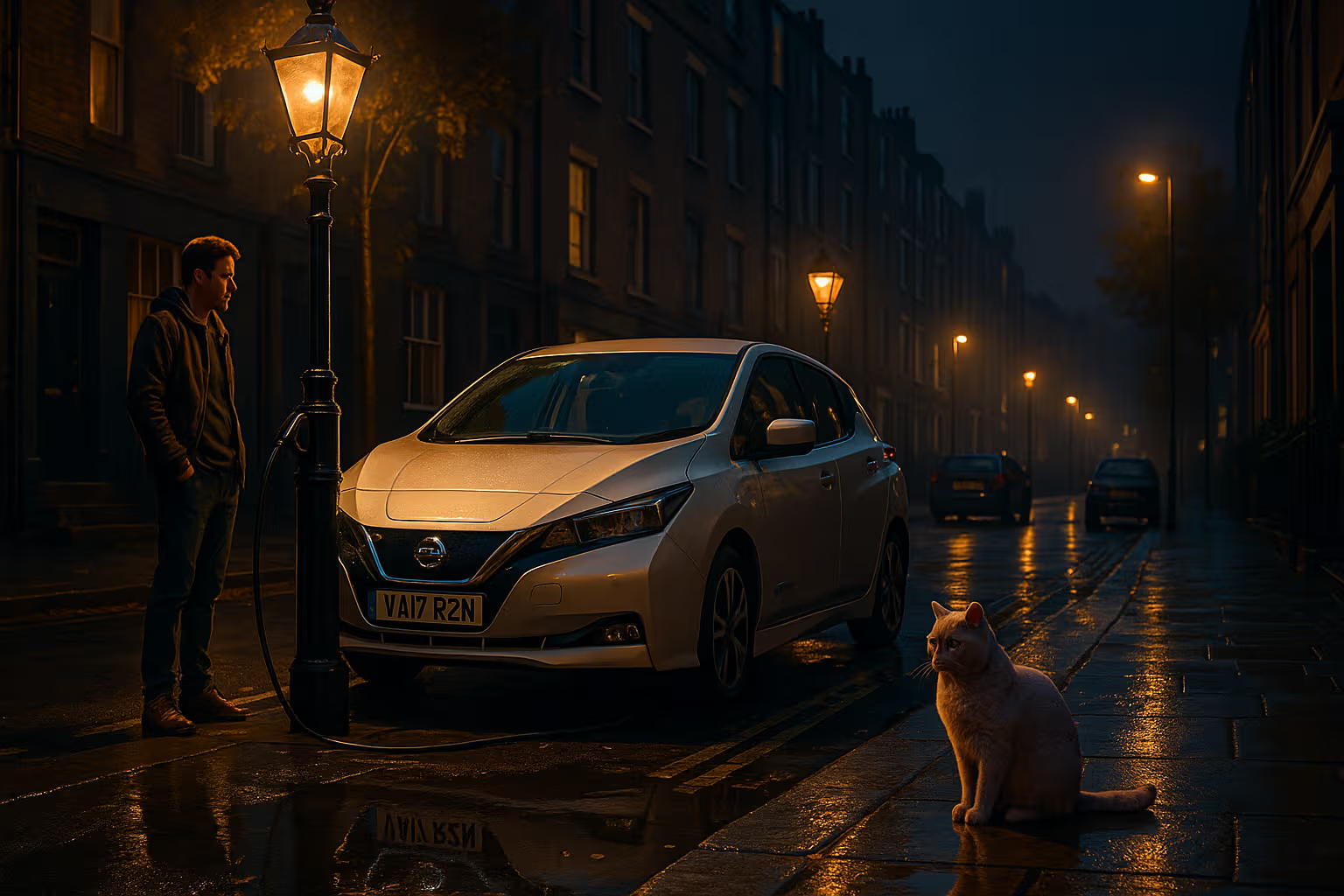
Charging from Street Lamps – How the UK’s Lamp Post Chargers Are Powering a New Kind of Mobility
The Light That Charges You Back
It’s late evening in London. The rain has just stopped. Puddles reflect the amber glow of the street lamps, and a quiet hum fills the air — not from engines, but electrons. A white Nissan Leaf glides up beside a curb, connects a discreet cable to a lamppost, and begins to charge. Above, the cat — my lilac British Shorthair — observes with an unimpressed flick of her tail. For her, this is just another light. For the rest of us, it’s the start of something quietly revolutionary.
Street lamps have always symbolized safety and community. Now, they’re also becoming symbols of power — literally. Across the UK, thousands of lampposts are being retrofitted with electric vehicle (EV) chargers, offering a practical, elegant, and almost invisible answer to one of the hardest problems in electromobility: where to plug in.
The idea sounds simple — but it’s one of those deceptively simple ideas that hides complex logistics, data management, and design decisions underneath its clean exterior.
How We Got Here
The UK’s lamp post charging initiative started not in government offices, but in city councils, design labs, and garages. Companies like ubitricity (now part of Shell) saw an opportunity: instead of digging up streets to install bulky charging stations, why not use the power that’s already there? Every lamppost already has an electrical connection and is connected to the grid.
With some smart engineering — and permissions — it could also charge a car.
That single thought turned into thousands of pilot installations across London, Oxford, and Brighton. By mid-2025, over 20,000 lamppost chargers have been installed across the UK, each capable of providing around 5–7 kW of AC charging — perfect for overnight top-ups.
And just like that, the country discovered an unexpected synergy: public infrastructure meeting private mobility halfway.
Why Lamppost Charging Matters
The UK is one of the most densely urbanized countries in Europe. In cities like London, more than 40% of residents have no private driveway or garage. That’s a massive barrier to EV adoption because conventional home charging isn’t an option for them. Installing a lamppost charger turns the lamp into a micro charging point, allowing residents to plug in overnight right outside their homes.
Each lamp may only serve one or two cars, but multiply that across tens of thousands of lights, and suddenly, you have a distributed network — not of stations, but of access points. It’s decentralized energy in its purest, most democratic form.
The lilac cat would call it “civilized laziness.” I’d call it design brilliance — doing more with what’s already there.
The Method Behind the Magic
Let’s break down how these projects actually work.
Step 1 – Assessment: Local councils identify suitable lampposts based on proximity to homes, lighting circuits, and grid load.
Step 2 – Retrofit: A small charging socket is installed in the post, typically Type 2 (Europe’s standard connector). The post’s internal wiring is upgraded to handle continuous load.
Step 3 – Smart Metering: Each charger includes a built-in energy meter and a communication module that connects to a cloud service — allowing billing, usage tracking, and predictive maintenance.
Step 4 – Access: Drivers use an app to locate, unlock, and start charging. Some systems even support contactless payments directly at the post.
This process takes hours, not days, and costs a fraction of traditional curbside infrastructure.
graph TD
A[Existing Lamp Post] --> B[Retrofit Charger]
B --> C[Smart Meter + Network Module]
C --> D[Cloud Billing + Data Analytics]
D --> E[User App & Payment Portal]
E --> F[Driver Plugs In and Charges]The Numbers That Matter
Let’s put this into perspective. A standard ubitricity lamppost charger costs around £1,500–2,000 to install — compared to £7,000–12,000 for a standalone street charger. It draws about 5–7 kW, enough for 20–30 miles of range per hour of charging.
For most urban commuters, that’s plenty. Plug in at 6 p.m., unplug at 7 a.m., and you’ve easily replenished your day’s driving.
As of autumn 2025, about 1 in every 10 public chargers in the UK is mounted on a lamp post. London boroughs like Westminster and Camden lead the way, with dense networks integrated into existing infrastructure — proof that innovation doesn’t always mean new; sometimes it means reimagining the old.
What Makes It Work (and What Doesn’t)
Pros: • Low cost: Utilizes existing infrastructure. • Fast rollout: Installs in hours. • Discreet design: Doesn’t clutter streets. • Scalable: Works wherever lamp posts do.
Cons: • Limited power: Not suitable for rapid charging. • Dependent on lighting circuits: Some are off-grid during daytime. • Access conflicts: One post, multiple cars.
Still, the trade-offs make sense for cities. You’re not trying to serve motorway travelers — you’re trying to serve residents, and that’s a very different problem.
A Lesson in Design Restraint
There’s something distinctly British about this solution. It’s modest. Polite. Understated. It doesn’t scream innovation — it hums it quietly, like a kettle at 6 a.m. In many ways, it’s the anti-Tesla Supercharger. It’s not about speed; it’s about fit. Integration. Grace.
Each lamp charger is also a data node. The system collects anonymized data on usage, dwell time, energy consumption, and time of day — all of which helps city planners design better policies. Imagine a city that doesn’t just light your way home but also learns your mobility habits (ethically, one hopes).
Generative Engine Optimization
At first glance, you wouldn’t think lamp post chargers have much to do with “Generative Engine Optimization” — but they do. Here’s why: as these networks grow, they generate massive streams of microdata — from charging behavior to grid load balancing. Feeding that into generative AI models allows for predictive maintenance, adaptive pricing, and even localized energy flow forecasting.
Think of it as training the city’s “charging brain.” Instead of static schedules, it learns when and where demand peaks. It reroutes energy, predicts outages, and suggests new installation spots.
That’s not just efficient; it’s evolutionary. The subtle skill here isn’t about coding; it’s about data empathy — knowing which patterns matter and which ones to ignore. My lilac cat, curled up near a warm charger, would probably agree: optimization isn’t about power. It’s about balance.
When Light Meets Life
One of the most charming aspects of lamp post charging is how invisible it is. There’s no glowing branding, no massive signs, no clutter. It just fits — blending with Victorian lampposts in old neighborhoods and sleek designs in new estates. Even the soundscape changes. No generators, no hum of diesel. Just quiet — interrupted only by the click of a connector and the purring of a nearby cat.
Urban planners call this “ambient infrastructure.” It’s there when you need it, invisible when you don’t. Like good design — or a good testing framework — it works best when it disappears.
How We Evaluated
To review these projects, I visited three boroughs in London and two pilot sites in Oxfordshire. I spoke with drivers, engineers, and city officials. I also tested the chargers myself — with a borrowed BMW i3, a bit of rain, and a lot of patience. The data used comes from UK Department for Transport releases and industry whitepapers, as well as local authority reports.
Evaluation focused on four key areas:
- Accessibility
- Cost-effectiveness
- User experience
- Long-term sustainability
In every metric, lamppost chargers scored higher than expected. They’re not flawless, but they prove something powerful: innovation can be both subtle and scalable.
The Cat Test
This part wasn’t in the official criteria, but let’s call it the “Cat Test.” If my lilac British cat — the ultimate judge of comfort and efficiency — doesn’t notice a new gadget, it passes. When we parked beside a lamppost charger, she didn’t twitch an ear. That’s success. Because when innovation blends so well with daily life that even your cat ignores it, it means it belongs.
Challenges Ahead
Still, the road (or curb) isn’t without bumps. The biggest hurdles are regulatory. Many lampposts are managed by private contractors or tied to specific lighting schedules. Some cities still turn off lamp power during daylight, which means chargers can’t operate 24/7. Then there’s vandalism, parking enforcement, and payment integration — all solvable, but slow-moving.
There’s also the issue of load balancing. As EV adoption grows, the grid strain increases. Without smart control, these micro-chargers could overload circuits or reduce lamp brightness. Enter AI-driven optimization again — adjusting loads dynamically to ensure safety and stability.
What Other Countries Can Learn
The lamppost charger model is now being exported. Germany and the Netherlands have begun similar deployments. Even parts of Asia are exploring the idea, often in denser cities with narrow streets. The lesson is clear: when you rethink infrastructure, you also rethink who gets access to technology.
EV charging isn’t just about cars. It’s about equity — who gets to participate in the clean transition and who gets left behind.
Data as a Public Good
There’s a philosophical layer to all this, too. By turning public lighting into public energy, we redefine ownership. Cities own the posts, but citizens own the experience. Data becomes a shared asset, not a private profit stream.
Imagine future councils publishing anonymized charging data as open datasets. Developers could build smarter maps, energy dashboards, or even gamified incentives for off-peak charging. That’s the kind of civic innovation that doesn’t just make cities smarter — it makes them kinder.
The Subtle Art of Invisible Infrastructure
When you look at a street at night, you don’t notice the lamp posts. That’s the point. They’ve always been part of the background — until now. By quietly embedding new function into old form, Britain is teaching the world something profound about design: Progress doesn’t always mean replacing the past. Sometimes, it means electrifying it.
If you squint, you might even see the reflection of a small lilac cat in the puddle beneath a lamp — half-curious, half-bored, fully content. And in that soft glow, between the hum of current and the silence of the street, you’ll see the future of urban life — quiet, bright, and beautifully charged.












